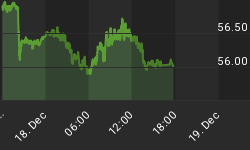Below is an extract from a commentary originally posted at www.speculative-investor.com on 13th November, 2008.
Anyone who thinks that changes in the fabrication-related (jewellery, etc.) demand for gold are important determinants of the gold price is looking at the gold market as if total supply were roughly the same as annual mine supply (annual fabrication demand is equivalent to a large percentage of annual mine supply). However, the supply coming from mines adds less than 2% per year to the total aboveground gold supply. In other words, those who focus on fabrication demand and mine supply are, in effect, basing their analyses on less than 2% of the gold market. The other 98% of the market is clearly where the focus should be, and that 98% is governed by changes in investment demand.
In the short-term, prices are moved by factors such as sentiment changes and margin calls; and these factors are often unpredictable. For example, there is no way of knowing the financial situations of the large speculators that dominate the trading of COMEX gold futures, and, consequently, no way of quantifying the risk that these speculators will be forced sellers of gold in the near-term. It is therefore possible that an extension of the de-leveraging trend will push the gold price to new lows for the year over the coming days, although the Commitments of Traders data suggest that a lot of de-leveraging has already taken place and that a move to new lows would be short-lived.
When considering the outlook for the next 6 months or longer, the only gold-bearish argument that currently holds any water is the deflation-related one. If the forces of deflation overwhelmed the efforts of central banks such that the total supply of money began to contract, then gold would probably keep performing well in terms of most other commodities but would perform poorly in terms of the deflating currencies. As a result, we would not be intermediate-term bullish on gold if we thought that genuine deflation (a contraction in the money supply) was a likely outcome.
It could also be argued that even if the money supply continues to grow at a robust rate, the outward signs of inflation will become less evident over the year ahead and this will lead to weaker investment demand for gold. We view this argument as having less validity than the one related to monetary deflation, but not because we expect the prices of everyday items to remain in strong upward trends. On the contrary, we fully expect inflationary effects to become less pronounced over the coming year. In fact, this is a point we began making when inflation fears were at their highs during the second quarter of this year. Our point, then and now, is that the prices of everyday goods and services surged during 2006-2008 in response to the rapid money-supply growth that occurred during the first few years of the decade, but that the next phase will entail a substantial slowing in the general price level's rate of ascent in response to the relatively slow money-supply growth of 2005-2007. (Note: M3 did not reveal this important monetary trend change, but TMS did.)
Our expectation that the outward evidence of inflation will dissipate is supported by the performance of the Future Inflation Guide (FIG) calculated by the Economic Cycle Research Institute (ECRI). Despite its name, the FIG has nothing to do with monetary inflation; rather, it is a leading indicator of the prices of goods and services. Specifically, it is designed to indicate what will be happening to prices in 6-12 months time. As illustrated by the following chart, the FIG (the blue line) has plunged over the past few months.

The superficial signs of an inflation problem will almost certainly subside over the next 12 months, but this should not create a significant headwind for gold as long as the rate of monetary inflation continues to rise. As discussed in the past, the reason is that savvy speculators will likely accumulate positions in gold in anticipation of the eventual/inevitable effects of the monetary inflation.
We only have to go back to 2001 for a historical example of what we are referring to. Gold's long-term bull market began in April of 2001 -- a time when the FIG was at a multi-year low and in freefall.
We aren't offering a free trial subscription at this time, but free samples of our work (excerpts from our regular commentaries) can be viewed at: http://www.speculative-investor.com/new/freesamples.html.















